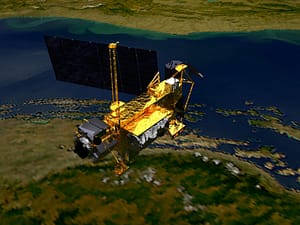 For the past few weeks, NASA scientists have been closely monitoring a dead satellite that is plummeting toward earth.
For the past few weeks, NASA scientists have been closely monitoring a dead satellite that is plummeting toward earth.
As of Friday Sept. 23, 2011, at 10:30a.m. EST, NASA’s Upper Atmosphere Research Satellite, or UARS, is expected to re-enter Earth’s atmosphere late Friday night or early Saturday morning, EST. Tonight the 6 1/2-ton satellite could make its uncontrolled “death plunge” through Earth’s atmosphere, after the end of a productive scientific life.
NASA scientists cannot yet determine exactly where the satellite will land but earlier said it will fall over a region somewhere between the latitudes of northern Canada and southern South America. Today NASA said there is a low probability any debris that survives re-entry will land in the United States, but the possibility cannot be discounted because of this changing rate of descent
It is still too early to predict the time and location of re-entry with any certainty, but predictions will become more refined in the next 12 to 18 hours.
Most of the bus-sized satellite will burn up and break into several pieces as it descends through the earth’s atmosphere. NASA predicted 26 large pieces of supersonic debris will survive all the way and hit the earth’s surface. The debris could weigh up to 330 pounds a piece, and will stretch along a 500-mile path.
The risk to public safety or property is extremely small, according to NASA’s website. There is a 1-in-3,200 chance of satellite debris hitting a person on the ground, odds that NASA says are extremely remote. Other experts agree. To date, there have been no confirmed reports of an injury or significant property damage resulting from re-entering space objects. Nor is there a record of significant property damage resulting from a satellite re-entry.
According to NASA”s website:
As of 10:30 a.m. EDT on Sept. 23, 2011, the orbit of UARS was 100 miles by 105 miles (160 km by 170 km). Solar activity is no longer the major factor in the satellite’s rate of descent, (which was causing the satellite to crash into earth sooner than expected). Now the satellite’s orientation or configuration apparently has changed, and that is now slowing its descent.
NASA’s UARS satellite was the first multi-instrumented satellite to observe numerous chemical constituents of the atmosphere with a goal of better understanding atmospheric photochemistry and transport. The defunct bus-size spacecraft was launched in 1991 and then shut down in 2005 after completing its mission.
NASA will post updates about 12 hours, six hours and two hours before re-entry. The updates will come from the Joint Space Operations Center of U.S. Strategic Command at Vandenberg Air Force Base, Calif., which works around the clock detecting, identifying and tracking all man-made objects in Earth orbit, including space junk.
NASA has advised the public that if you find something you think may be a piece of UARS, do not touch it. You should contact a local law enforcement official for assistance.
For more information, go to NASA’s website.